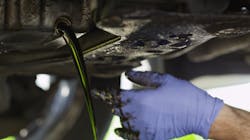Considerations for used oil and oil filter management
Any shop completing regular maintenance on vehicles comes into contact with used oil and used oil filters, as engine oil changes are completed regularly on fleet vehicles.
Because of this, maintenance facilities have a responsibility to properly handle and dispose of these materials to ensure shop safety and adhere to government regulations.
The results of improper used oil disposal can range between an inconvenience to a catastrophic shop, community or global issue. Monitored by federal, state and local regulations to protect the environment and leverage natural resources, improperly disposed of used oil can cause soil and watershed contamination. Having a more direct impact, cleanup of a spill in the shop can be messy and time-consuming.
There are procedures, equipment and services to consider when it comes to the proper handling and disposal of used oil and oil filters.
Definition of “used oil”
Used motor oil never wears out, it simply becomes “dirty” with use.
The U.S. Environmental Protection Agency (EPA) defines used oil as any type of refined crude oil or synthetic oil used for lubrication purposes which contains physical or chemical impurities. Physical contaminants may include metal shavings or dirt, while chemical contaminants refers to items such as solvents or water.
As a generator of used oils, it is the shop’s responsibility to ensure the contents of the used oil and confirm if it should be categorized as hazardous waste.
Used oil is categorized as on-specification or off-specification. On-spec used oil includes acceptable levels of halogens (under 1,000 parts per million) such as arsenic or lead, and denotes if it can be handled under used oil guidelines or burned for energy recovery. Off-spec used oil is considered hazardous waste, and additional disposal guidelines should be followed.
A shop is responsible for the used oil analysis to confirm the category of used oil before the oil leaves the shop. Shops should consider not mixing used engine oil with other oils to help monitor the contents of the used oil. As a general rule, unmixed used oil is easier to identify and manage.
Proper handling of used oil
There are certain steps technicians should take to ensure safe handling and disposal of the used oil during an engine oil change.
“Make sure that oil is in an environmentally safe container, so it’s contained and protected from leaks or spills to the environment,” says Vivek Bedi, CEO of ESOC Commercial Truck (esocinc.com), a provider of fluid management systems.
The U.S. EPA recommends ensuring storage containers and tanks remain in good condition, without rust, leaks or deterioration, and to fix any issues immediately. The organization encourages all used oil storage containers and tanks be labeled as “used oil,” and to never store used oil in anything other than the designated tanks and storage containers.
In addition to these guidelines, the State of Washington’s Department of Ecology provides additional considerations for handling used oil in the shop:
- Use signage to separate containers and/or areas housing used oil from other wastes at the shop, and train your employees in the importance of keeping wastes separate.
- Store used oil in a leak-proof, closed container.
- Drain and collect all oil on a covered and curbed, impermeable surface area away from drains.
- Do not open, handle, manage or store containers and tanks in a manner that may cause them to leak or rupture.
- Be prepared to stop, contain and clean up any releases of used oil.
- Take steps to prevent the accidental contamination of your used oil with even small amounts of solid or dangerous waste.
- Physically inspect all used oil storage containers and tanks on a regular basis.
- Know the on-spec/off-spec status of your used oil before it leaves the shop.
- Know whether your used oil is prohibited from burning as used oil prior to it leaving your site.
- Know how your used oil will be disposed of or recycled before it leaves the shop.
- If possible, keep all containers stored inside or under cover.
It is important to follow up with state environmental protection agency guidelines to ensure proper used oil handling and disposal.
In addition to a designated tank or tanks for storing used oil, shops should have portable equipment to use during the oil change event.
There are a number of used oil handling systems shops can use to evacuate and contain used oil during a vehicle oil change. Most systems will have wheels for portability, and mesh filters to avoid larger items or solid debris from entering the waste oil container. Basic designs may be a simple receptacle or drain for the used oil, while others provide additional features such as a closed loop system to allow for the removal of used oil and addition of fresh oil to the vehicle.
“The advantages to [closed loop] systems are the worker is not exposed to the oil,” explains Bedi. “The oil is removed in a systematic way and disposed of automatically to a dedicated waste tank. Then the worker is not exposed to it, and the environment is not exposed to it.”
What about the oil filters?
Made from steel, previously used oil filters were oftentimes disposed of in landfills. Today, however, the steel-based materials are more often recycled.
Recycling one ton of drained oil filters produces 1,700 pounds of steel and recovers about 60 gallons of used oil, according to the Mid-America Regional Council (MARC), a non-profit city and county government association for the Kansas City region.
Shops can opt to dispose of or recycle filters themselves, or have a service provider collect the materials for disposal or recycling.
The U.S. EPA requires that used oil filters be drained of all free-flowing oil before they are discarded or recycled. Shops typically handle the draining of this oil one of two ways: through gravity draining – where the filter is left for a certain amount of time until the used oil sufficiently drains; or by crushing the oil filter with proper equipment to remove excess oil.
Most used oil is removed from the filter during hot-draining. Hot-draining refers to the process of draining the oil from the vehicle at or above 60 degrees F; often completed at or near engine operating temperature. This means the oil is drained and filter removed from the engine while it is still warm.
Currently, U.S. manufactured oil filters are exempt from hazardous waste regulation if the oil filter is:
- Punctured through the dome end or anti-drain back valve and hot-drained.
- Hot-drained and crushed.
- Hot-drained and dismantled.
- Hot-drained using an equivalent method to remove used oil.
The U.S. EPA recommends hot-draining for a minimum of 12 hours, although specific state requirements may vary.
Using shop air, some oil handling systems such as those available from ESOC, also evacuate excess used oil from the oil filters with the filter still attached to the engine.
“Those filters are completely dry and they’re ready for immediate disposal,” ESOC’s Bedi explains. “You don’t have to puncture them, you don’t have to crush them. You can just pull them off [the vehicle].”
Some equipment manufacturers such as Bendpak offer oil filter crushers, which operate with the use of shop air in order to quickly crush and remove residual oil and debris from the used oil filter.
Next steps for used oil
Once oil has been used, it can be collected, then properly disposed of, or recycled and used again. An estimated 380 million gallons of used oil are recycled each year, according to the U.S. EPA.
There are a number of methods to recycle used oil. They include:
- Reconditioning oil on-site to remove impurities. This method extends the life of the oil, but does not restore the fluid to its original condition.
- Adding the used oil into a petroleum refinery, as feedstock during refinery production.
- Re-refining the used oil to remove impurities, then using the refined fluid as a base stock for new lubricating oil. Re-refined oil is the preferred form of recycling by the U.S. EPA, because it allows the oil to be reused over and over again, using less energy and less virgin oil.
- Used oil can be processed and burned for energy recovery. After removing water and particulates from the used oil, the oil can be used to generate heat or power machinery.
For shops considering handling their own used oil disposal, oil burning units can provide shop heat, and offer a cost-efficient and environmentally conscious method for disposing.
For shops that opt to contract the collection of used oil, service providers will either dispose of the used oil by way of landfill or oil burning or opt to re-refine the oil into a useable product.
“Oil has an amazing life cycle,” says ESOC’s Bedi. “If you approach it the right way, you can reuse a motor oil in multiple ways outside of its original use.”
About the Author
Erica Schueller
Media Relations Manager | Navistar
Erica Schueller is the Media Relations Manager for Navistar.
Before joining Navistar, Schueller served as Editorial Director of the Endeavor Commercial Vehicle Group. The commercial vehicle group includes the following brands: American Trucker, Bulk Transporter, Fleet Maintenance, FleetOwner, Refrigerated Transporter, and Trailer/Body Builders brands.
An award-winning journalist, Schueller has reported and written about the vehicle maintenance and repair industry her entire career. She has received accolades for her reporting and editing in the commercial and automotive vehicle fields by the Truck Writers of North America (TWNA), the International Automotive Media Competition (IAMC), the Folio: Eddie & Ozzie Awards and the American Society of Business Publication Editors (ASBPE) Azbee Awards.
Schueller has received recognition among her publishing industry peers as a recipient of the 2014 Folio Top Women in Media Rising Stars award, acknowledging her accomplishments of digital content management and assistance with improving the print and digital products in the Vehicle Repair Group. She was also named one Women in Trucking’s 2018 Top Women in Transportation to Watch.
She is an active member of a number of industry groups, including the American Trucking Associations' (ATA) Technology & Maintenance Council (TMC), the Auto Care Association's Young Auto Care Networking Group, GenNext, and Women in Trucking.
In December 2018, Schueller graduated at the top of her class from the Waukesha County Technical College's 10-week professional truck driving program, earning her Class A commercial driver's license (CDL).
She has worked in the vehicle repair and maintenance industry since 2008.

